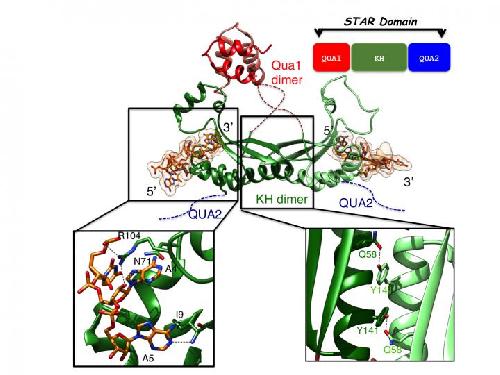A team from the University of Leicester has for the first time published a detailed description of a protein linked to many types of cancer.
The lab-based study from the Department of Molecular and Cell Biology now provides an opportunity for scientists to develop drugs to target this protein.
Dr Cyril Dominguez who led the work at Leicester said: "My research field is structural biology. The proteins that we have studied, called Sam68 and T-STAR, are very similar and overexpression of Sam68 has been shown to correlate with poor prognosis in many types of cancers.
 Top: Overview of the structure of T-STAR STAR domain in complex with AUUAAA RNA. Bottom left: close up view of the specific recognition of the RNA. Bottom right: close up view of the KH dimerization interface. Credit: University of Leicester
Top: Overview of the structure of T-STAR STAR domain in complex with AUUAAA RNA. Bottom left: close up view of the specific recognition of the RNA. Bottom right: close up view of the KH dimerization interface. Credit: University of Leicester
"Our results provide atomic resolution details on how Sam68 binds specifically to its RNA target. Furthermore, we show that Sam68 forms a homodimer that has never been described before and is crucial for its function in RNA splicing.
"This is important because this basic research set the grounds for structure-based drug design approaches. If we can identify or design drugs that bind specifically at the dimerization interface, we will be able to prevent the function of these proteins in cells, which could have implications for novel cancer treatments.
"Now that we have a high-resolution structure of Sam68 and T-STAR and a high-throughput binding assay, we are in discussion to collaborate with a major drug discovery consortium to screen a very large library of compounds to inhibit the function of Sam68."
Dr Dominguez's work has been published in Nature Communications. He said: "Thanks to an MRC Career Development Award, I started my own research lab in 2010, and we were in competition with other well-established laboratories. This article is therefore the consecration of our hard work during the last five years."
source: University of Leicester